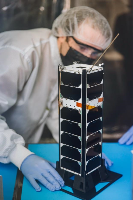| Spacecraft | DARLA (Demonstration of Artificial Reasoning, Learning, and Analysis) |
|---|---|
| Type | CubeSat |
| Units or mass | 3U |
| Status | not launched, expected in 2025 |
| Launcher | not launched, (ELaNa 42) |
| Organization | Saint Louis University |
| Institution | University |
| Entity type | Academic / Education |
| Headquarters | US |
| Oneliner |
Educational mission to test spacecraft platform and on-board event detection using commercial imagers and SDRs. |
| Description |
A 3U Cubesat mission with the following objectives.
The spacecraft carries a software-defined-radio receiver and generates an on-board dynamic UHF map of the world. Using this map as a baseline, the spacecraft will then entire into science mode where it attempts to detect new RF events and geolocate them. We plan to have our mission benefit the amateur radio service and community as a whole via our experiment of RF detection. The spacecraft carries software-defined-radios (receiving only) that scan the UHF and VHF bands for emissions (center frequency and RSSI only; no decoding). In addition to more detailed data collected on board, the spacecraft will broadcast near-real-time updates of the RF environment in a twice-per-minute short packet burst. The nominal design is to broadcast the center frequency and RSSI detected for the six loudest signals in UHF and VHF bands. However, those the particulars can be adjusted if a different set of data would be of more use to the radio amateur community. We believe that this information can not only showcase to both our students and the general public the application of radio analysis, but also radio amateurs in revealing possible interference issues on the ground. Furthermore, we believe that amateur radio operators can help contribute to the mission by communicating RF events they may have detected on the ground to see if this same event was detected via our satellite. Lastly, with the ability to upload new experiments are just a few ideas we have in benefitting both the amateur satellite service as well as amateurs around the globe. |
| Sources | [1] [2] [3] [4] |
| Photo sources | [1] |
Last modified: 2024-12-09



